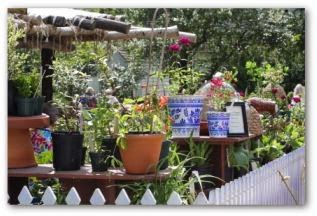Pot-scaping simply takes containers of plants
off their traditional pedestals, such as balconies, decks, windowsills, and
moves them into a broad landscape.
It involves the artful grouping of container-grown plants. These groupings become mine-gardens,
adding a touch of color to bare patches in the landscape.
Container gardening is showing up in beds and
borders or standing alone. Busy
homeowners find decorating their yards with “spots of pots” an easy way to
splash color through the yard.
The possibilities for container gardening are
endless. Anything that grows in
the garden will grow in containers: annuals, perennials, dwarf trees, shrubs or
vegetables. Tropical plants in
containers are becoming very popular here. Many homeowners are decorating their decks, patios and
landscapes with tropical container plants that have bold textured leaves, like
banana trees, citrus trees and elephant ears. Some exotic varieties, unless brought indoors during winter,
won’t survive Ohio’s winter weather. (In the past few years, some hardy tropical plants
that can be used in this area, have come on the market. Be sure to check the care tag for
zones.) If you do try to over-winter
the non-hardy type, place plant in a large south-facing window. Then move it outdoors in the
summer. You will not corner the
market on fruit production, but it will form fruit. Some people treat the tropical plants as annuals, replacing
them every year.
Containers come in a variety of sizes, shapes
and materials. What you choose
will depend on the type of plant and the location. Beware of decorative planters that lack drainage holes. This creates water-logged soil and
rotting roots. Research shows that
the old practice of placing a layer of gravel in the bottom of the container,
to give some room for water to accumulate with out saturating the soil, doesn’t
really work. If you want to use a decorative
planter that doesn’t have a drain hole, put your plants in a regular flowerpot
and place it inside the decorative container.
The new lightweight containers made from
polished styrene and foam core, are making container gardens more
versatile. You can move pots
around more easily, to change the dynamic of your outdoor space.
It seems gardeners are putting high priority on
plants with long term, all season color.
The experts tell us the big colors are red, gold and
purple. If you like these colors,
then go with the trend. If you
want something else, remember landscaping is 98% personal preference and your
point of view is the most important view.
TOM’S TIMELY TIPS FOR JUNE
• Move
houseplants to shaded areas outside
for the summer. Be aware that plants will need more water
during hot and
windy weather.
• Heavy
rains encourage slug problems. Check for slugs during rainy periods and hand pick the pests.
• For
hanging baskets in cool, shady locations, use tuberous begonias, ferns,
impatiens or fibrous
rooted begonias in combination with trailing plants, such
as English Ivy.
• Remove
old flower heads from annual bedding plants to keep them blooming.
• Remove
foliage from spring bulbs after it turns yellow and begins to dry. Set out bedding plants to
cover the
bare spots using care not to damage the bulbs.
• Use bark mulch
around young trees to protect them from lawn mower damage.
• Spring
flowering shrubs such as spirea, viburnum, lilac and forsythia should be pruned
as soon as they are done blooming.
.




No comments:
Post a Comment